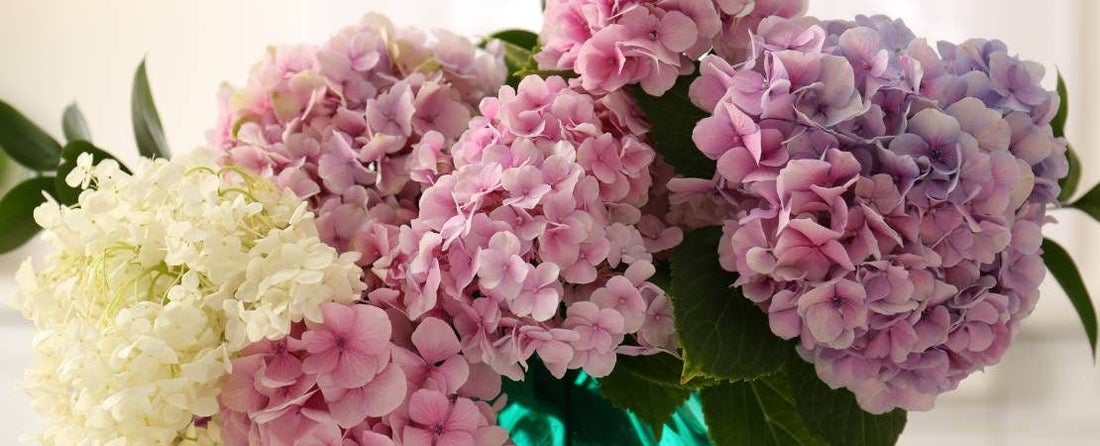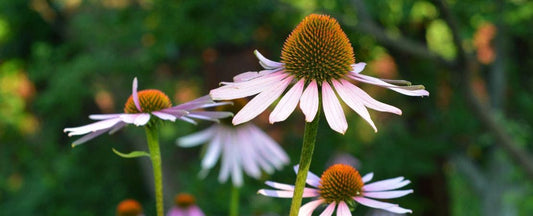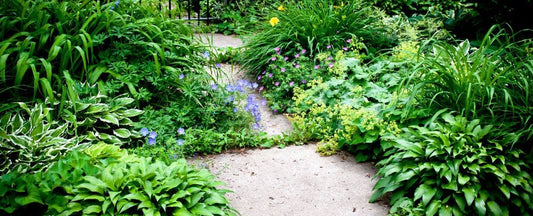How to Revive Hydrangea Cut Flowers

Tips to Help Cut Hydrangea Blooms Last
Hydrangea blooms can look fresh in arrangements for a month or more when given the proper care.
Hydrangeas are beloved for their large, lush blooms and vibrant colors. However, it's not uncommon for cut hydrangeas to droop and appear lifeless shortly after being arranged. The good news is that these flowers often aren't dead and can be revived with a few simple techniques. Here's a step-by-step guide to help you bring your cut hydrangea flowers back to life.
IMPORTANT NOTE: Hydrangeas have hollow stems. When we use scissors to cut stems, it crushes the xylem and phloem and this is a major cause of the hydrangea wilt in a vase, followed by dirty water and bacteria. Always use a floral knife, or any sharp knife, when cutting and trimming stems of hydrangeas. In fact, when cutting any flower for arranging, our experts suggest using a knife instead of scissors whenever possible to avoid crushing flower stems.
Supplies Needed
- Sharp floral knife (or any sharp knife)
- A clean vase
- Clean water
- Floral preservative (optional)
Steps to Revive Drooping Hydrangeas
When you see the hydrangeas drooping in the vase, take these steps to refresh and revive them.
1. Prepare a Clean Vase
Start by thoroughly cleaning your vase to remove any bacteria that could hinder the revival process. Fill it with lukewarm water. If you have floral preservative, add it to the water according to the package instructions.
2. Rinse and Trim the Stems
Rinse the drooping hydrangea stems. The, using a sharp knife, carefully trim about 2 to 3 inches from the bottom of each hydrangea stem at a 45-degree angle. This angle increases the surface area for water absorption and prevents the stem from resting flat against the bottom of the vase.
3. Plunge into Clean Water
Immediately after trimming the stems, plunge them into the vase filled with clean water. Ensure that the stems are fully submerged.
4. Hydrate and Rest
Place the vase in a cool, shaded area away from direct sunlight and drafts. Allow the hydrangeas to hydrate and rest for several hours or overnight. You should start to see improvement within a few hours as the flowers rehydrate and regain their firmness.
5. Maintain Hydration
Keep an eye on the water level in the vase and refill as needed. Hydrangeas are thirsty flowers and will absorb a significant amount of water. Change the water every couple of days to keep it fresh and free of bacteria.
Additional Tips
- Repeat Steps 2 and 3:If the blooms don’t bounce back (whether due to the first fresh cut not fully addressing the blocked xylem or the water’s bacteria going further up the stem), trim a few more inches from the stem. Your bouquets will get shorter, but you’ll have revived blooms for another week+.
- Submerge the Entire Flower: Submerge the whole wilted bloom in water for a quicker bounce back after the fresh cut.
- Use Alum: Another effective method is to dip the cut end of the stem in alum powder (commonly found in the spice section of grocery stores) before placing it in water. This can help to improve water uptake.
- Cool Storage:If the flowers are particularly wilted, you can place the entire arrangement in a refrigerator for a few hours to help revive them.
Preventing Future Drooping
- Cut Hydrangeas in the Morning: When cutting hydrangeas from your garden, do so in the early morning when the plants are most hydrated.
- Use a Floral Knife: When cutting hydrangea flowers from the shrub, use a knife instead of scissors or pruners to avoid crushing the stems.
- Condition the Stems: After cutting, immediately place the stems in water before and while arranging them.
By following these steps, you can often bring seemingly lifeless hydrangea cut flowers back to their full, beautiful glory. Proper hydration and care are key to maintaining their freshness and longevity in your arrangements.





